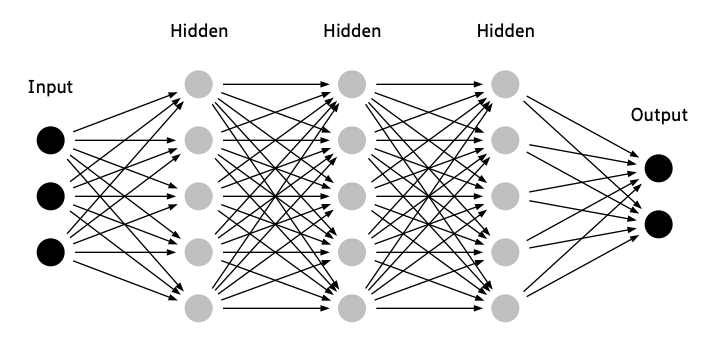Introduction
In this notebook, we will predict the status of a machine (working or failing) based on temperature and vibration sensor readings. This notebook builds on theoretical concepts from the course, including:
- Neural network architecture
- Activation functions
- Layers and neurons
- Training via backpropagation
We use TensorFlow in this notebook because it simplifies the process of building and training neural networks, making it easier for beginners to focus on core concepts like layers, activation functions, and training. With its high-level Keras API, TensorFlow handles complex operations like backpropagation and gradient updates for us, allowing for readable, intuitive code. This approach helps learners grasp the fundamentals without being overwhelmed by implementation details, while also providing the scalability to explore advanced features later.
Follow along step by step and execute each cell to see the theory in action.
Step 1: Import Libraries
We start by importing the necessary libraries. These include:
- TensorFlow: For building and training the neural network.
- NumPy: For numerical operations and data generation.
- Matplotlib: For data visualization.
- Scikit-learn: For data preprocessing and splitting.
import tensorflow as tf
from tensorflow.keras import Sequential
from tensorflow.keras.layers import Dense, Dropout
import numpy as np
import matplotlib.pyplot as plt
from sklearn.model_selection import train_test_split
from sklearn.preprocessing import StandardScaler
import ipywidgets as widgets
from IPython.display import display, clear_output
print("Libraries imported successfully!")
Step 2: Generate Synthetic Data
We simulate sensor readings for machine status prediction. The data consists of:
- Working Machines: Normal operating ranges (temperature: ~50°C, vibration: ~20 m/s²).
- Failing Machines: Higher temperature and vibration values (temperature: ~75°C, vibration: ~45 m/s²).
This data is generated using random distributions to mimic real-world variability.
def generate_training_data(n_samples=1000):
np.random.seed(42)
n_working = int(n_samples * 0.6)
n_failing = n_samples - n_working
# Working machines
temp_working = np.random.normal(50, 5, n_working)
vib_working = np.random.normal(20, 3, n_working)
# Failing machines
temp_failing = np.random.normal(75, 5, n_failing)
vib_failing = np.random.normal(45, 5, n_failing)
# Combine data
X = np.vstack([
np.column_stack([temp_working, vib_working]),
np.column_stack([temp_failing, vib_failing])
])
y = np.array([0] * n_working + [1] * n_failing)
return X, y
X, y = generate_training_data(1000)
# Show data samples
print(f"Temperature samples: {X[:5, 0]}")
print(f"Vibration samples: {X[:5, 1]}")
print(f"Labels: {y[:5]}")
Step 3: Visualize the Data
To understand the data distribution, we plot temperature and vibration readings for both working and failing machines.
plt.figure(figsize=(10, 6))
plt.scatter(X[y==0, 0], X[y==0, 1], c='blue', label='Working Machines')
plt.scatter(X[y==1, 0], X[y==1, 1], c='red', label='Failing Machines')
plt.title("Temperature vs. Vibration")
plt.xlabel("Temperature (°C)")
plt.ylabel("Vibration (m/s²)")
plt.legend()
plt.grid(True)
plt.show()
Step 4: Prepare the Data
Before training, we split the data into:
- Training Set: 80% of the data, used for training the model.
- Testing Set: 20% of the data, used to evaluate the model.
We also normalize the features to ensure all input values are on a similar scale.
X_train, X_test, y_train, y_test = train_test_split(X, y, test_size=0.2, random_state=42)
# Normalize data
scaler = StandardScaler()
X_train_scaled = scaler.fit_transform(X_train)
X_test_scaled = scaler.transform(X_test)
print("Data prepared for training.")
Step 5: Build the Neural Network Model
We build a simple neural network with the following architecture:
- Input Layer: 2 input features (temperature, vibration).
- Hidden Layer: 16 neurons with ReLU activation.
- Output Layer: 1 neuron with Sigmoid activation for binary classification.
model = Sequential([
Dense(16, activation='relu', input_dim=2),
Dense(1, activation='sigmoid')
])
model.compile(optimizer='adam', loss='binary_crossentropy', metrics=['accuracy'])
print("Model created.")
Step 6: Train the Model
We train the model using backpropagation for 50 epochs with a batch size of 32. The loss is minimized using binary crossentropy.
history = model.fit(
X_train_scaled, y_train,
epochs=50,
batch_size=32,
validation_split=0.2,
verbose=1
)
print("Training complete.")
Step 7: Evaluate the Model
We evaluate the model on the test data to measure its accuracy and ensure it generalizes well.
test_loss, test_accuracy = model.evaluate(X_test_scaled, y_test)
print(f"Test Loss: {test_loss:.4f}, Test Accuracy: {test_accuracy:.4f}")
Step 8: Interactive Prediction
Use the sliders below to input temperature and vibration values. The model will predict whether the machine is working or failing.
def predict_status(temp, vib):
input_data = np.array([[temp, vib]])
input_scaled = scaler.transform(input_data)
prediction = model.predict(input_scaled)[0][0]
return "Failing" if prediction > 0.5 else "Working"
def create_interface():
temp_slider = widgets.FloatSlider(value=50, min=30, max=90, step=0.5, description='Temperature (°C):')
vib_slider = widgets.FloatSlider(value=20, min=10, max=60, step=0.5, description='Vibration (m/s²):')
output = widgets.Output()
def update(change):
with output:
clear_output()
status = predict_status(temp_slider.value, vib_slider.value)
print(f"Temperature: {temp_slider.value}°C")
print(f"Vibration: {vib_slider.value} m/s²")
print(f"Prediction: {status}")
temp_slider.observe(update, names='value')
vib_slider.observe(update, names='value')
display(widgets.VBox([temp_slider, vib_slider, output]))
create_interface()
